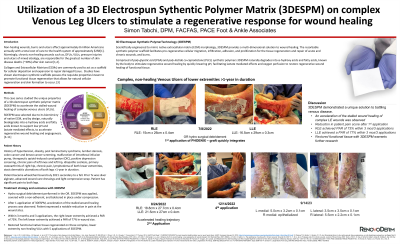Case Series/Study
(CS-147) Utilization of a 3D Electrospun Sythentic Polymer Matrix (3DESPM) on complex venous leg ulcers to stimulate a regenerative response for wound healing

Collagen and Extracellular Matrices (ECMs) are commonly used and act as a scaffold for cellular migration, adherence and proliferation in wound healing. Studies have shown electrospun synthetic scaffolds possess the requisite properties known to promote functional tissue regeneration that allows for natural cellular regeneration and skin formation to occur. [1]
Methods:
This case series studied the unique role of a 3D electrospun synthetic polymer matrix (3DESPM) as a clinical resource to accelerate the stalled wound healing process of complex venous ulcers. 3DESPM was selected due to its biomimicry of native ECM, and by design, naturally biodegrades into α-hydroxy acids and fatty acids known to support low pH and lactate-mediated effects, that aid in regenerative wound healing and angiogenesis. [2-6]
Results:
Patient has a history of hypertension, overweight, post laminectomy syndrome, lumbar stenosis, colon cancer screening, breast cancer screening, malfunction of intrathecal infusion pump, therapeutic opioid-induced constipation (OIC), positive depression screening, chronic pain of left knee, left hip pain, idiopathic scoliosis, ulcer of lower extremity, limited to breakdown of skin (HCC), primary osteoarthritis of right hip, chronic pain syndrome, lymphedema of both lower extremities, stasis dermatitis of both legs.
Patient became wheelchair bound July 2021 secondary to a fall. Had wounds to both the Right Lateral and Right Medial Extremities. Patient developed Left Lower Extremity wounds after pressure from wheelchair. Prior Tx was silver alginate, advanced wound care dressings and light compressive wrap. Patient has significant pain to both legs.
Assessment: Right Lower Extremity measured 15cm x 26cm x 0.4cm. Left Lower Extremity measured 16.5cm x 29cm x 0.3cm
Patient was taken into the OR for debridement. 3DESPM was applied, covered with a non-adherent, bolstered in place under compression.
Within 7 days after application of 3DESPM, granular tissue buds were present.
Within 3.5 months an acceleration of the stalled wound healing process was observed after 3rd application of 3DESPM. Right lower extremity wound achieving a 73% reduction in size. Left lower extremity wounds achieving a 77% reduction in size.
Healthy trajectory continued.
Within 6.5 months and 5 applications of 3DESPM, functional native tissue has been regenerated on this complex venous ulcer that was persistent for greater than 1 year.
Discussion:
3DESPM demonstrated a unique solution to battling venous disease. An acceleration in the stalled wound healing of complex lower extremity wounds and the regeneration of functional tissue with 3D ESPM warrants further research.
Trademarked Items:
References: 1. Wissing, et al, 2017
2Jones, E.M., C.A. Cochrane, and S.L. Percival, The Effect of pH on the Extracellular Matrix and Biofilms. Adv Wound Care (New Rochelle), 2015. 4(7): p. 431-439.
3. Gethin, G., The significance of surface pH in chronic wounds. Wounds UK, 2007. 3.
4. B, G., et al., Proteases and pH in chronic wounds. Journal of Wound Care, 2005. 14(2): p. 59-61.;
5. TK, H. and B. S, Theoretical and Practical Aspects of Oxygen in Wound Healing, in The Wound Management Manual, L. B, Editor. 2005, McGraw-Hill: New York. p. 44-54.
6. Leveen, H.H., et al., Chemical acidification of wounds. An adjuvant to healing and the unfavorable action of alkalinity and ammonia. Annals of surgery, 1973. 178(6): p. 745-753

.png)